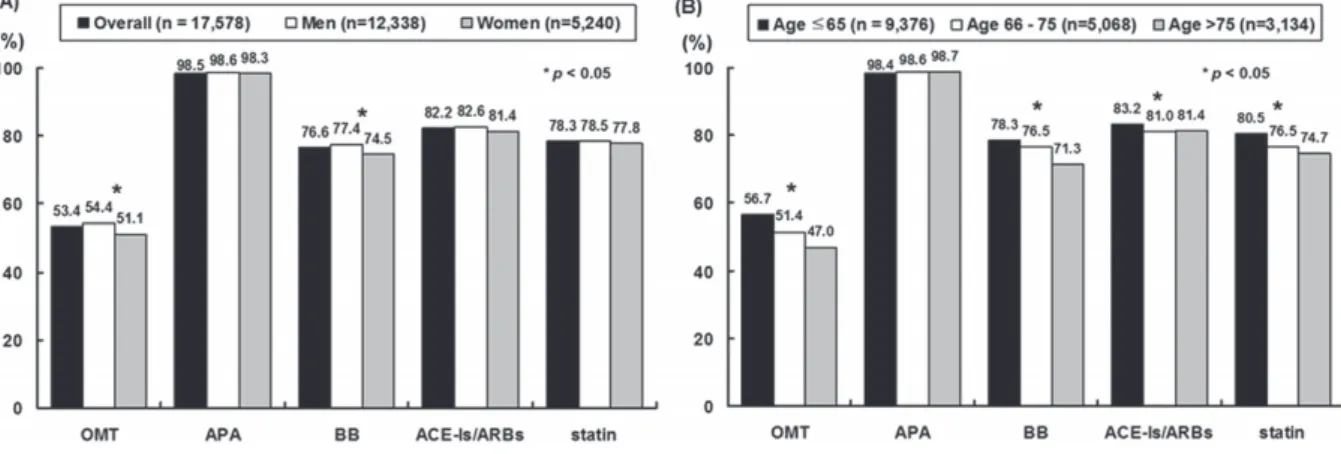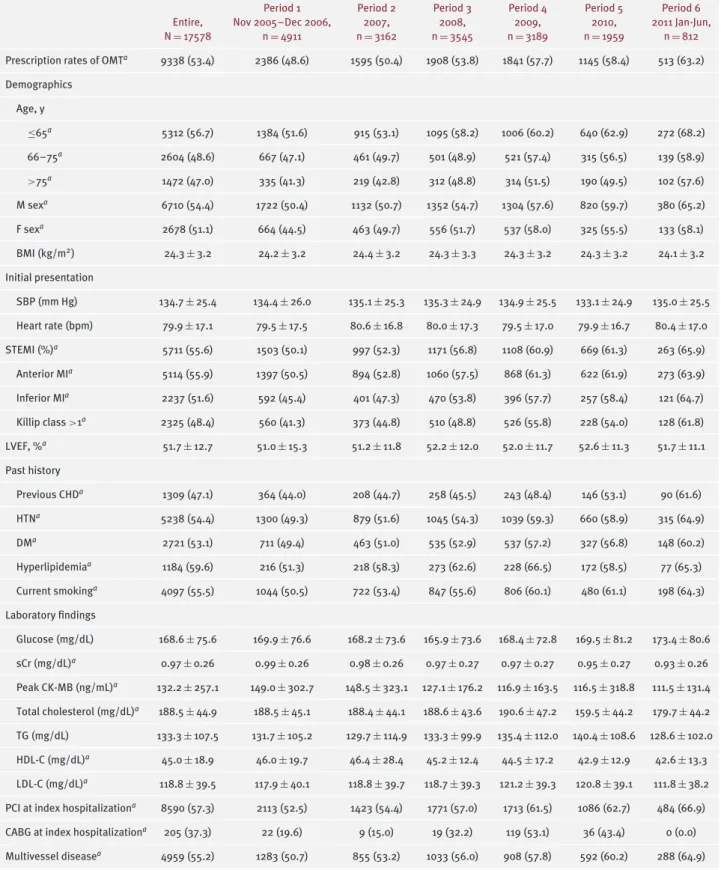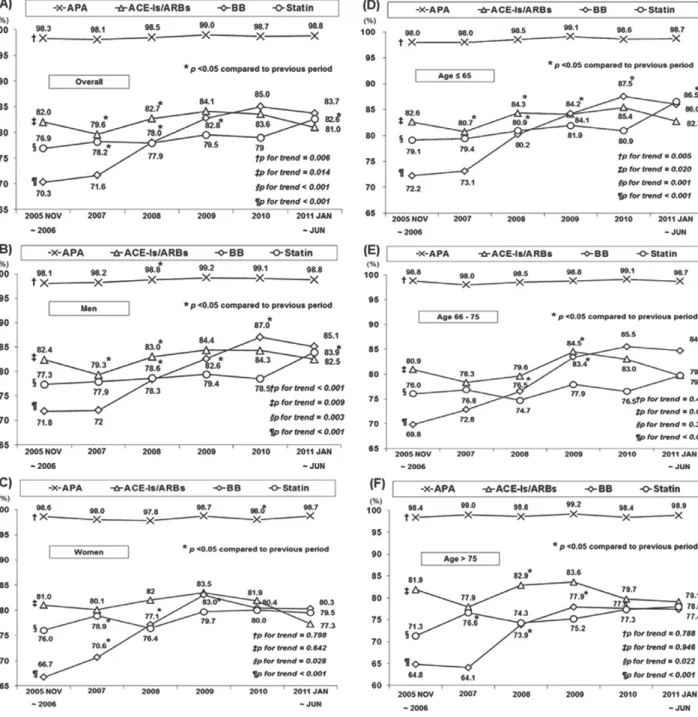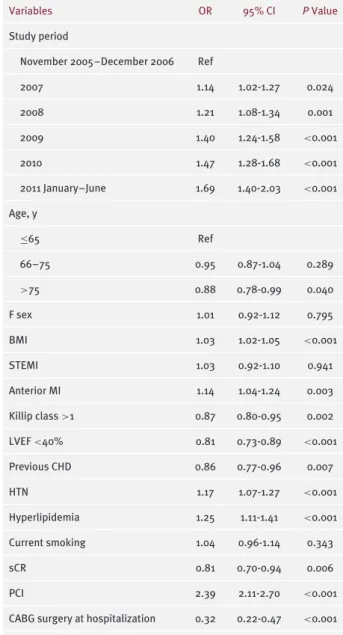Address for correspondence:
Shung Chull Chae, MD Department of Internal Medicine Kyungpook National University Hospital
50 Samduk 2-Ga
Daegu 700–721, Republic of Korea scchae@knu.ac.kr
Clinical Investigations
Contemporary Trends of Optimal Evidence-Based Medical Therapy at Discharge for Patients Surviving Acute
Myocardial Infarction From the Korea Acute Myocardial Infarction Registry
Jang Hoon Lee, MD; Myung Hwan Bae, MD; Dong Heon Yang, MD; Hun Sik Park, MD;
Yongkeun Cho, MD; Myung Ho Jeong, MD; Young Jo Kim, MD; Kee-Sik Kim, MD; Seung Ho Hur, MD; In Whan Seong, MD; Myeong Chan Cho, MD; Chong Jin Kim, MD; Shung Chull Chae, MD; for the Korea Acute Myocardial Infarction Registry Investigators Department of Internal Medicine (Lee, Bae, Yang, Park, Y. Cho, Chae), Kyungpook National University Hospital, Daegu, Republic of Korea; Department of Internal Medicine (Jeong), Chonnam National University Hospital, Gwangju, Republic of Korea; Department of Internal Medicine (Y.J. Kim), Yeungnam University Hospital, Daegu, Republic of Korea; Department of Internal Medicine (K.-S. Kim), Daegu Catholic University Hospital, Daegu, Republic of Korea;
Department of Internal Medicine (Hur), Keimyung University Dongsan Medical Center, Daegu, Republic of Korea; Department of Internal Medicine (Seong), Chungnam National University Hospital, Daejeon, Republic of Korea; Department of Internal Medicine (M.C. Cho), Chungbuk National University College of Medicine, Cheongju, Republic of Korea; Department of Internal Medicine (C.J. Kim), Kyung Hee University East–west Neo Medical Center, Seoul, Republic of Korea
Background: Temporal trends of evidence-based optimal medical therapy (OMT) at discharge after acute myocardial infarction (AMI) have not been investigated in recent years.
Hypothesis: OMT should have been increased in AMI and gap between guidelines and practices in its use should have been narrowed.
Methods: We examined discharge medications of 17,578 post-MI patients who had no documented contraindications to antiplatelet agents, β-blockers, angiotensin-converting enzyme inhibitors, or statins across a 6-year period (divided into subperiods of November 2005 to December 2006 [period 1], 2007 [period 2], 2008 [period 3], 2009 [period 4], 2010 [period 5], and January to June 2011 [period 6]) in the Korean AMI Registry. OMT was defined as use of all 4 indicated medications.
Results: Marked increases in OMT (48.6% to 63.2%) were seen irrespective of age and sex, mainly attributed to marked increases in the use of β-blockers (70.3% to 83.7%) and statins (76.9% to 82.6%) from period 1 to period 6. The gap in use of OMT between men and women narrowed over time between the first and second 3 periods, but not between the young and the elderly. Advanced age (odds ratio [OR]: 0.88, P = 0.04) was independently associated with underuse of OMT. Adjusted ORs for OMT from period 1 to period 6 were as follows: 1, 1.14 (P = 0.024), 1.21 (P = 0.001), 1.40 (P < 0.001), 1.47 (P < 0.001), and 1.69 (P < 0.001), respectively.
Conclusions: Despite gradual increase in OMT over time, the gap between guidelines and practices in use of OMT continues to exist.
Introduction
Although previous studies reported that the use of evidence-based optimal medical therapy (OMT), defined as the use of all 4 indicated medications
The authors have no funding, financial relationships, or conflicts of interest to disclose.
such as antiplatelet agents, β-blockers, angiotensin- converting enzyme inhibitors/angiotensin receptor block- ers (ACEIs/ARBs), and lipid-lowering drugs (statins), in hospital patients after acute myocardial infarction (AMI) increased markedly over time, OMT remains underused for secondary prevention in Asia as well as in Western countries.
1–
12Therefore, current guidelines for the man- agement of AMI have recommended increasing utilization
350 Clin. Cardiol. 38, 6, 350–356 (2015) Received: November 3, 2014
Figure 1. Use of each medication at discharge according to (A) sex and (B) age. Abbreviations: ACEIs/ARBs, angiotensin-converting enzyme inhibitors/angiotensin II receptor blockers; APA, antiplatelet agents; BB, β-blockers; OMT, optimal medical therapy.
rates of OMT in all post-MI patients unless contraindi- cated.
13,14Accordingly, clinicians may wonder how many patients are receiving OMT year by year in the current guideline-directed medical therapy era. There are sev- eral investigations about the recent trends in discharge medications
15–
17; however, those studies did not primarily focus on the temporal trend of discharge medications, but rather on guideline adherence at the time of discharge and during follow-up.
The primary objective of this study was to describe the current status of, as well as temporal change in, prescription of 4 effective cardiac medications in post-MI patients between 2005 and 2011. Although guidelines for the use of these medications do not differentiate treatment on the basis of age or sex, women and the elderly are treated less aggressively with OMT than men and younger post-MI patients.
10–
12,18However, limited data are available for the recent trend of OMT according to age and sex. Therefore, a secondary goal of this study was to determine whether the use of 4 effective cardiac medications at discharge differs on the basis of age or sex.
Methods
The Korean AMI Registry is a prospective, open, observa- tional, multicenter, online registry of AMI established with support of the Korean Society of Cardiology. It has been in operation since November 2005.
3Between November 2005 and June 2011, 29999 patients with a final diagnosis of AMI at admission were recruited into the Korean AMI Registry. Of these patients, baseline clinical data were available for 29 819. The in-hospital mortality was 6.0% (n = 1795); thus, 28 024 patients with AMI survived to hospital discharge.
AMI was diagnosed on the basis of characteristic clinical presentation, serial changes on electrocardiogram suggesting infarction, and increase in cardiac enzymes.
19All patients were considered to be eligible for antiplatelet agents unless they had a history of life-threatening bleeding, coagulopathy, or thrombocytopenia. Contraindications to β- blockers were defined as significant bradycardia (heart rate
<50 bpm) or hypotension (systolic blood pressure <90 mm Hg). ACEIs/ARBs were indicated in patients with heart
failure, left ventricular dysfunction (left ventricular ejection fraction [LVEF] <40%), hypertension, or diabetes mellitus (DM) for non–ST-segment elevation MI, and in patients with anterior location, heart failure, or LVEF ≤40% for ST-segment elevation MI unless they had hypotension and severe renal dysfunction (serum creatinine [sCr]
>2.5 mg/dL in men or >2.0 mg/dL in women). All patients with AMI were considered to be eligible for statins unless they had a statin intolerance. In the present study, we excluded 2683 (9.6%) patients with incomplete data for discharge medications, 4886 (17.4%) patients who were not indicated in ACEI/ARB use, and 3118 (11.1%) patients with documented contraindications to antiplatelet agents, β-blockers, or ACEIs/ARBs. The number of patients with contraindications to these medications was as follows: 1086 (3.9%), significant bradycardia; 1084 (3.9%), hypotension;
880 (3.1%), severe renal dysfunction; and 68 (0.2%), major bleeding. Finally, 17 578 patients with AMI who survived to hospital discharge were included in analysis. All data were recorded on an electronic Web page–based case-report form. The protocol was approved by the ethics committee of each participating institution.
Data are expressed as mean ± SD for continuous variables
and percentages for categorical variables. Differences in
various characteristics of patients prescribed OMT across
the 6-year period were assessed using analysis of variance
(ANOVA) for continuous variables and the χ
2test for
categorical variables. Changes over time in the percentage
of patients treated with the 4 cardiac medications were
examined using χ
2tests for trends. Univariate analyses
were performed to determine the clinical predictors of
OMT. Variables associated with the use of OMT were
assessed using the Student t test for continuous variables
and the χ
2test for categorical variables. Multivariate logistic-
regression models were constructed to examine changing
trends in the use of OMT overall and according to age
and sex while controlling for factors possibly affecting
prescription of the medications. These factors included
variables with a P value <0.05 on univariate analysis, such
as patient age, sex, body mass index, type of MI, location
of MI, Killip class, LVEF, previous coronary heart disease
(CHD), hypertension, hyperlipidemia, smoking status, sCr
levels, percutaneous coronary intervention, and coronary
Table 1. Characteristics in Patients Receiving OMT According to Study Period
Period 1 Period 2 Period 3 Period 4 Period 5 Period 6
Entire, N = 17578
Nov 2005–Dec 2006, n = 4911
2007, n = 3162
2008, n = 3545
2009, n = 3189
2010, n = 1959
2011 Jan-Jun, n = 812 Prescription rates of OMT
a9338 (53.4) 2386 (48.6) 1595 (50.4) 1908 (53.8) 1841 (57.7) 1145 (58.4) 513 (63.2) Demographics
Age, y
≤65
a5312 (56.7) 1384 (51.6) 915 (53.1) 1095 (58.2) 1006 (60.2) 640 (62.9) 272 (68.2)
66–75
a2604 (48.6) 667 (47.1) 461 (49.7) 501 (48.9) 521 (57.4) 315 (56.5) 139 (58.9)
>75
a1472 (47.0) 335 (41.3) 219 (42.8) 312 (48.8) 314 (51.5) 190 (49.5) 102 (57.6)
M sex
a6710 (54.4) 1722 (50.4) 1132 (50.7) 1352 (54.7) 1304 (57.6) 820 (59.7) 380 (65.2)
F sex
a2678 (51.1) 664 (44.5) 463 (49.7) 556 (51.7) 537 (58.0) 325 (55.5) 133 (58.1)
BMI (kg/m
2) 24.3 ± 3.2 24.2 ± 3.2 24.4 ± 3.2 24.3 ± 3.3 24.3 ± 3.2 24.3 ± 3.2 24.1 ± 3.2
Initial presentation
SBP (mm Hg) 134.7 ± 25.4 134.4 ± 26.0 135.1 ± 25.3 135.3 ± 24.9 134.9 ± 25.5 133.1 ± 24.9 135.0 ± 25.5 Heart rate (bpm) 79.9 ± 17.1 79.5 ± 17.5 80.6 ± 16.8 80.0 ± 17.3 79.5 ± 17.0 79.9 ± 16.7 80.4 ± 17.0
STEMI (%)
a5711 (55.6) 1503 (50.1) 997 (52.3) 1171 (56.8) 1108 (60.9) 669 (61.3) 263 (65.9)
Anterior MI
a5114 (55.9) 1397 (50.5) 894 (52.8) 1060 (57.5) 868 (61.3) 622 (61.9) 273 (63.9)
Inferior MI
a2237 (51.6) 592 (45.4) 401 (47.3) 470 (53.8) 396 (57.7) 257 (58.4) 121 (64.7)
Killip class >1
a2325 (48.4) 560 (41.3) 373 (44.8) 510 (48.8) 526 (55.8) 228 (54.0) 128 (61.8)
LVEF, %
a51.7 ± 12.7 51.0 ± 15.3 51.2 ± 11.8 52.2 ± 12.0 52.0 ± 11.7 52.6 ± 11.3 51.7 ± 11.1
Past history
Previous CHD
a1309 (47.1) 364 (44.0) 208 (44.7) 258 (45.5) 243 (48.4) 146 (53.1) 90 (61.6)
HTN
a5238 (54.4) 1300 (49.3) 879 (51.6) 1045 (54.3) 1039 (59.3) 660 (58.9) 315 (64.9)
DM
a2721 (53.1) 711 (49.4) 463 (51.0) 535 (52.9) 537 (57.2) 327 (56.8) 148 (60.2)
Hyperlipidemia
a1184 (59.6) 216 (51.3) 218 (58.3) 273 (62.6) 228 (66.5) 172 (58.5) 77 (65.3) Current smoking
a4097 (55.5) 1044 (50.5) 722 (53.4) 847 (55.6) 806 (60.1) 480 (61.1) 198 (64.3) Laboratory findings
Glucose (mg/dL) 168.6 ± 75.6 169.9 ± 76.6 168.2 ± 73.6 165.9 ± 73.6 168.4 ± 72.8 169.5 ± 81.2 173.4 ± 80.6 sCr (mg/dL)
a0.97 ± 0.26 0.99± 0.26 0.98 ± 0.26 0.97± 0.27 0.97± 0.27 0.95 ± 0.27 0.93± 0.26 Peak CK-MB (ng/mL)
a132.2 ± 257.1 149.0 ± 302.7 148.5 ± 323.1 127.1 ± 176.2 116.9 ± 163.5 116.5 ± 318.8 111.5 ± 131.4 Total cholesterol (mg/dL)
a188.5 ± 44.9 188.5 ± 45.1 188.4 ± 44.1 188.6 ± 43.6 190.6 ± 47.2 159.5 ± 44.2 179.7 ± 44.2 TG (mg/dL) 133.3 ± 107.5 131.7 ± 105.2 129.7 ± 114.9 133.3 ± 99.9 135.4 ± 112.0 140.4 ± 108.6 128.6 ± 102.0 HDL-C (mg/dL)
a45.0 ± 18.9 46.0 ± 19.7 46.4 ± 28.4 45.2 ± 12.4 44.5 ± 17.2 42.9 ± 12.9 42.6 ± 13.3 LDL-C (mg/dL)
a118.8 ± 39.5 117.9 ± 40.1 118.8 ± 39.7 118.7 ± 39.3 121.2 ± 39.3 120.8 ± 39.1 111.8 ± 38.2 PCI at index hospitalization
a8590 (57.3) 2113 (52.5) 1423 (54.4) 1771 (57.0) 1713 (61.5) 1086 (62.7) 484 (66.9) CABG at index hospitalization
a205 (37.3) 22 (19.6) 9 (15.0) 19 (32.2) 119 (53.1) 36 (43.4) 0 (0.0) Multivessel disease
a4959 (55.2) 1283 (50.7) 855 (53.2) 1033 (56.0) 908 (57.8) 592 (60.2) 288 (64.9)
Abbreviations: BMI, body mass index; CABG, coronary artery bypass grafting; CHD, coronary heart disease; CK-MB, creatine kinase-MB; Dec, December;
DM, diabetes mellitus; F, female; HDL-C, high-density lipoprotein cholesterol; HTN, hypertension; Jan, January; Jun, June; LDL-C, low-density lipoprotein cholesterol; LVEF, left ventricular ejection fraction; M, male; MI, myocardial infarction; Nov, November; OMT, evidence-based optimal medical therapy;
PCI, percutaneous coronary intervention; SBP, systolic blood pressure; sCR, serum creatinine; SD, standard deviation; STEMI, ST-segment elevation myocardial infarction; TG, triglycerides.
Data are expressed as mean ± SD or n (%).
a




